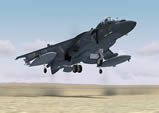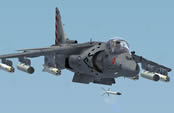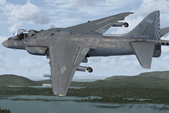Similar Products
Boeing AV-8B Harrier II Plus



Fly the Harrier
RAZBAM is proud to unveil the AV-8B Harrier II Plus. Fly the last version of the jump jet made famous in the Falklands War. Try and master Vertical Take-Off and Landing. Fly CAS missions, with the full suit of ordnance available.
Available versions
Microsoft Flight Simulator X and Lockheed Martin Prepar3D:
NOTE: FSX version requires either Acceleration
Description
The McDonnell Douglas (now Boeing) AV-8B Harrier II is a second-generation vertical/short takeoff and landing (V/STOL) ground-attack aircraft. An Anglo-American development of the British Hawker Siddeley Harrier, the Harrier II is the final member of the Harrier family. The AV-8B is primarily used for light attack or multi-role missions, and is typically operated from small aircraft carriers, large amphibious assault ships and simple forward operating bases. The AV-8B is used by the United States Marine Corps (USMC), Armada Española (Spanish Navy) and Marina Militare (Italian Navy). A variant of the AV-8B, the British Aerospace Harrier II was developed for the British military. The TAV-8B is a dedicated two-seat trainer version. The Harrier II and other models of the Harrier family have been called "Jump Jets".
AV-8Bs have participated in numerous conflicts, providing close air support for ground troops and performing armed reconnaissance, proving themselves versatile assets. US Army General Norman Schwarzkopf named the USMC Harrier as one of the seven most important weapons of the Gulf War. The aircraft took part in combat during the Iraq War beginning in 2003. The Harrier II has served in Operation Enduring Freedom in Afghanistan since 2001, and was used in Operation Odyssey Dawn in Libya in 2011. Italian and Spanish Harrier IIs participated in overseas conflicts, in conjunction with NATO coalitions.
General Characteristics (AV-8B Plus Radar)
Crew: 1
Length: 46 ft 4 in (14.12 m)
Wingspan: 30 ft 4 in (9.25 m)
Height: 11 ft 8 in (3.55 m)
Wing area: 243.4 ft² (22.61 m²)
Empty weight: 13,968 lb (6,340 kg)
Loaded weight: 22,950 lb (10,410 kg)
Powerplant: 1× Rolls-Royce F402-RR-408 (Mk 107) vectored-thrust turbofan, 23,500 lbf (105 kN)
Performance
Maximum speed: Mach 1.0 (585 knots, 673 mph, 1,083 km/h)
Range: 1,200 nmi (1,400 mi, 2,200 km)
Combat radius: 300 nmi (350 mi, 556 km)
Ferry range: 1,800 nmi (2,100 mi, 3,300 km)
Rate of climb: 14,700 ft/min (4,485 m/min)
Wing loading: 94.29 lb/ft² (460.4 kg/m²)
Armament
Guns: 1× General Dynamics GAU-12 Equalizer 25 mm (0.984 in) 5-barreled gatling cannon mounted under-fuselage in the left pod, with 300 rounds of ammunition in the right pod
Hardpoints: 6× under-wing pylon stations holding up to 13,200 lb (5,988 kg) of payload:
Rockets: 2× LAU-10 rocket pods (each with 7× 127 mm Mk 32 Zuni rockets)
Missiles:
Air-to-air missiles:
+ 4× AIM-9 Sidewinder or similar-sized infrared-guided missiles
+ 4× AIM-120 AMRAAM (on radar equipped AV-8B Plus variants)
Air-to-surface missiles:
+ 4× AGM-65 Maverick; or
Bombs:
o Mark 80 series of unguided bombs
o Cluster bombs
o Paveway series of laser-guided bombs
o Joint Direct Attack Munitions (GBU-54)
Others:
o up to 4 × 300/330/370 US Gallon drop tanks (pylon stations No. 2, 3, 4 & 5 are wet plumbed)
o Intrepid Tiger II electronic jammer.
Avionics
o Raytheon APG-65 radar
o AN/AAQ-28V LITENING targeting pod (on radar-equipped AV-8B Plus variants)
o AN/ALQ-164 RF Jammer pod
Special note: An upgrade program is currently fitting airframes with wiring and software to employ MIL-STD-1760 bus-based smart weapons, such as Joint Direct Attack Munitions